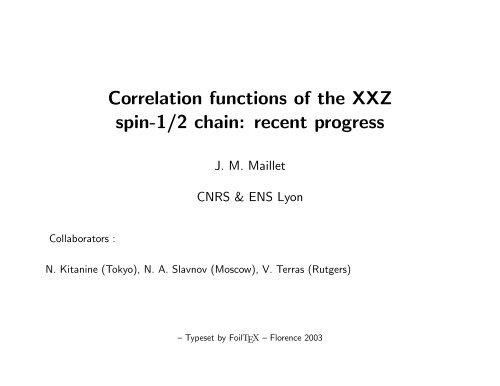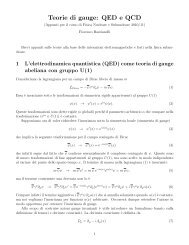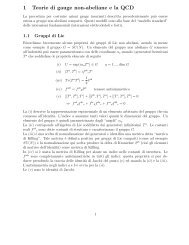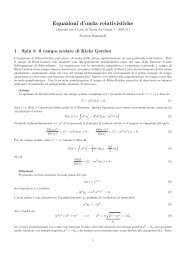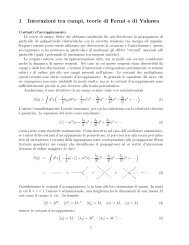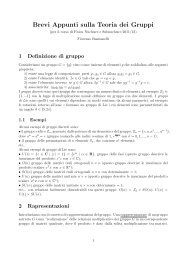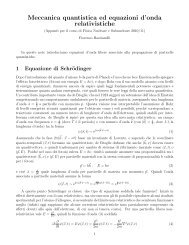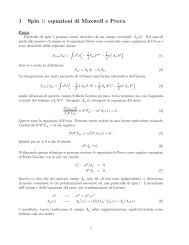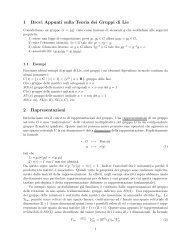Correlation functions of the XXZ spin-1/2 chain: recent progress
Correlation functions of the XXZ spin-1/2 chain: recent progress
Correlation functions of the XXZ spin-1/2 chain: recent progress
Create successful ePaper yourself
Turn your PDF publications into a flip-book with our unique Google optimized e-Paper software.
<strong>Correlation</strong> <strong>functions</strong> <strong>of</strong> <strong>the</strong> <strong>XXZ</strong><strong>spin</strong>-1/2 <strong>chain</strong>: <strong>recent</strong> <strong>progress</strong>J. M. MailletCNRS & ENS LyonCollaborators :N. Kitanine (Tokyo), N. A. Slavnov (Moscow), V. Terras (Rutgers)– Typeset by FoilTEX – Florence 2003
J. M. Maillet <strong>Correlation</strong> <strong>functions</strong>Quantum integrable modelsInterests• Exacts results not accessible by usual techniques• Direct applications : condensed matter, solid state physics,...• Ma<strong>the</strong>matics : quantum groups, knot <strong>the</strong>ory,...What can we compute?Hamiltonian spectrum, scattering matrix , partition function, critical exponents,....(Be<strong>the</strong>, Onsager, Yang, Baxter, McCoy, Faddeev, Zamolodchikov,...)<strong>Correlation</strong> <strong>functions</strong>?〈 O 〉 =tr H(O e −H/kT )tr H(e−H/kT )– Typeset by FoilTEX – Florence 2003 1
J. M. Maillet <strong>Correlation</strong> <strong>functions</strong><strong>Correlation</strong> <strong>functions</strong>Why is it so difficult? (Be<strong>the</strong> ansatz already 70 years old...!)For example at T=0 only <strong>the</strong> ground state |ψ g 〉 <strong>of</strong> H contributes :Three main problems to be solved :〈ψ g | O |ψ g 〉• Compute exact eigenstates and energy levels <strong>of</strong> <strong>the</strong> Hamiltonian (Be<strong>the</strong> ansatz)• Obtain <strong>the</strong> action <strong>of</strong> local operators on <strong>the</strong> eigenstates : main problem since eigenstatesare highly non-local!• Compute <strong>the</strong> resulting scalar products with <strong>the</strong> eigenstatesBeyond Ising type models (<strong>the</strong>re, use <strong>the</strong> free fermion algebra)...?(Lieb, Shultz, Mattis, Wu, McCoy,...)– Typeset by FoilTEX – Florence 2003 2
J. M. Maillet <strong>Correlation</strong> <strong>functions</strong>A very brief history...Three main lines <strong>of</strong> approach have been developped :• Bootstrap methods for <strong>the</strong> form factors + sums over all eigenstates (Karowski, Weisz,Smirnov,....)• Infinite volume + non-abelian quantum symmetries (Jimbo, Miwa,....)• Finite volume + algebraic Be<strong>the</strong> ansatz (Izergin, Korepin,...)−→ More <strong>recent</strong>ly a new approach :Algebraic Be<strong>the</strong> ansatz in finite volume + solution <strong>of</strong> <strong>the</strong> quantum inverse scatteringproblem (Kitanine, Maillet, Terras)−→ At zero temperature, and in <strong>the</strong> <strong>the</strong>rmodynamic limit, it leads to multiple integralrepresentations <strong>of</strong> <strong>the</strong> correlation <strong>functions</strong> for <strong>the</strong> <strong>XXZ</strong> <strong>spin</strong>-1/2 <strong>chain</strong>– Typeset by FoilTEX – Florence 2003 3
J. M. Maillet <strong>Correlation</strong> <strong>functions</strong>The <strong>spin</strong>-1/2 <strong>XXZ</strong> Heisenberg <strong>chain</strong>H = ∑ M(m=1 σxm σx m+1 + σy m σy m+1 + ∆ (σz m σz m+1 − 1)) − h ∑ M2 m=1 σz m• Hamiltonian eigenstates( A(λ)Algebraic Be<strong>the</strong> ansatz : σ α m −→ T (λ) = C(λ)B(λ)D(λ))T (λ) ≡ T a,1...N (λ) = L aN (λ − ξ N ) . . . L a1 (λ − ξ 1 )L an (λ) being 2 × 2 matrices with entries function <strong>of</strong> σ x,y,znoperators in site n.Yang-Baxter algebra : R 12 (λ 1 , λ 2 )T 1 (λ 1 )T 2 (λ 2 ) = T 2 (λ 2 )T 1 (λ 1 )R 12 (λ 1 , λ 2 )Commuting conserved charges : t(λ) = A(λ) + D(λ), [t(λ), t(µ)] = 0– Typeset by FoilTEX – Florence 2003 4
J. M. Maillet <strong>Correlation</strong> <strong>functions</strong>Hamiltonian : H = 2 sinh η ∂∂λ log t(λ)∣ ∣λ=η2+ c for all ξ j = 0.Eigenstates <strong>of</strong> t(µ) : |ψ〉 = ∏ k B(λ k)|0〉 with {λ k } solution <strong>of</strong> <strong>the</strong> Be<strong>the</strong> equations.• Action <strong>of</strong> local operators on eigenstatesResolution <strong>of</strong> <strong>the</strong> quantum inverse scattering problem : σ α m←−T (λ)σ − j=σ + j=∏j−1k=1j−1t(ξ k ) · B(ξ j ) ·∏t(ξ k ) · C(ξ j ) ·k=1j∏t −1 (ξ k ),k=1j∏t −1 (ξ k ),k=1j−1σ z j = ∏t(ξ k ) · (A− D ) (ξ j ) ·k=1j∏t −1 (ξ k ),k=1– Typeset by FoilTEX – Florence 2003 5
J. M. Maillet <strong>Correlation</strong> <strong>functions</strong>+ Yang-Baxter algebra for A, B, C, D to get <strong>the</strong> action on arbitrary states, for example〈0|N∏C(λ k ) A(λ N+1 ) =k=1N+1∑a ′ =1Λ a ′ 〈0|N+1∏C(λ k )k=1k≠a ′• Scalar products :〈0|N∏C(µ j )j=1N∏k=1B(λ k ) |0〉 = detU({µ j}, {λ k })detV ({µ j }, {λ k })for {λ k } a solution <strong>of</strong> Be<strong>the</strong> equations and {µ j } an arbitrary set <strong>of</strong> parameters, :U ab = ∂ λ aτ(µ b , {λ k }), V ab =1, 1 a, b N,sinh(µ b − λ a )where τ(µ b , {λ k }) is <strong>the</strong> eigenvalue <strong>of</strong> <strong>the</strong> transfer matrix t(µ b )– Typeset by FoilTEX – Florence 2003 6
J. M. Maillet <strong>Correlation</strong> <strong>functions</strong>Matrix elements <strong>of</strong> local operatorsFor example :〈0|N∏N∏C(µ j ) σ z nB(λ k ) |0〉 =j=1k=1= 〈0|N∏C(µ j )n−1∏t(ξ k ) · (A− D ) (ξ j ) ·n∏t −1 (ξ k )N∏B(λ k ) |0〉j=1k=1k=1k=1Here <strong>the</strong> sets {λ k } and {µ j } are both solutions <strong>of</strong> Be<strong>the</strong> equations −→〈0|N∏N∏C(µ j ) σ z nB(λ k ) |0〉 = Φ n 〈0|j=1k=1N∏C(µ j ) ( A − D ) N∏(ξ j ) B(λ k ) |0〉j=1k=1Hence it leads to determinant representations <strong>of</strong> <strong>the</strong>se matrix elements (using <strong>the</strong>scalar product formula)– Typeset by FoilTEX – Florence 2003 7
J. M. Maillet <strong>Correlation</strong> <strong>functions</strong><strong>Correlation</strong> <strong>functions</strong> : elementary blocksj=1F m ({ɛ j , ɛ ′ j }) = 〈ψ g | m ∏E ɛ′ j ,ɛ jj|ψ g 〉〈ψ g |ψ g 〉E ɛ′ ,ɛlk= δ l,ɛ ′δ k,ɛSolution <strong>of</strong> <strong>the</strong> quantum inverse scattering problem + Yang-Baxter algebra <strong>of</strong> operatorsT (λ) −→ Multiple integral formula for <strong>the</strong> correlation <strong>functions</strong>mF m ({ɛ j , ɛ ′ j }) = ( ∏∫k=1C h kdλ k ) Ω m ({λ k }, {ɛ j , ɛ ′ j }) S h({λ k })where Ω m ({λ k }, {ɛ j , ɛ ′ j }) is purely algebraic and S h({λ k }), C h kregime and <strong>the</strong> magnetic field h.are depending on <strong>the</strong>−→ Pro<strong>of</strong> <strong>of</strong> <strong>the</strong> results and conjectures <strong>of</strong> Jimbo, Miwa et al. and extension to <strong>the</strong> nonzero magnetic field h (a case where <strong>the</strong> quantum affine symmetry is broken)– Typeset by FoilTEX – Florence 2003 8
J. M. Maillet <strong>Correlation</strong> <strong>functions</strong>Physical correlation <strong>functions</strong>Example :〈ψ g |σ + 1 σ− m+1 |ψ g〉 ≡ 〈ψ g |E 121m∏j=2(E 11j+ E 22j) E21 m+1 |ψ g〉−→ sum <strong>of</strong> 2 m−1 elementary blocks: 〈ψ g |C( η 2 ) (A + D)m−1 ( η 2 ) B(η 2 )|ψ g〉Compact and symmetrized formula for <strong>the</strong> multiple action <strong>of</strong> A + D operators−→ Two point correlation <strong>functions</strong> :m−1〈σ α 1 σβ m+1 〉 = ∑n=0∮Cz∫ ∫d n+1 z d n λC λCµd 2 µ [f({λ, z})] m Γ αβn({λ, µ, z}) S h({λ, z})−→ Gives directly known free fermion results setting ∆ = 0−→ Asymptotics <strong>of</strong> two point <strong>functions</strong> for general ∆?– Typeset by FoilTEX – Florence 2003 9
J. M. Maillet <strong>Correlation</strong> <strong>functions</strong>Emptiness formation probabilityfor ∆ = cos ζ, 0 < ζ < π :τ(m) =limξ 1 ,...ξm→− iζ 21m!τ(m) = 〈ψ g |∫ ∞−∞m∏k=11 − σ z k|ψ g 〉2()Z m ({λ}, {ξ})idet m∏m2ζ sinhsinh(ξ a − ξ b )π ζ (λ j − ξ k )abFor ζ = π/3 : τ(m) = ( )1 m2 ∏ m−12 k=0( √3 ) 3m2(3k+1)!(m+k)! → c 2m − 36, 5m → ∞– Typeset by FoilTEX – Florence 2003 10
J. M. Maillet <strong>Correlation</strong> <strong>functions</strong>Idea <strong>of</strong> <strong>the</strong> pro<strong>of</strong> : Observe first that for ζ = π/3,−mZ m ({λ}, {ξ}) = (−1)m2 2m∏ sinh 3(ξ b − ξ a )2 m2 +m sinh(ξa>b b − ξ a ) sinh(ξ a − ξ b )(() det1m×det m (sinh(λ j − ξ k ) sinh(λ j − ξ k − iζ) det m)1sinh(λ j −ξ k + iπ 3 )1sinh 3(λ j −ξ k )) .Usingsinh(3x) = 4 sinh(x) sinh(x + iπ/3) sinh(x − iπ/3).τ(m, {ξ j }) =×∫ ∞−∞( 3i4π) m(−1) m2 −m22 m2 m!m∏a>bsinh 3(ξ b − ξ a )sinh(ξ b − ξ a )m∏a,b=1a≠bsinh −1 (ξ a − ξ b )() ()d m 11λ det msinh(λ j − ξ k + iπ 3 ) det msinh(λ j − ξ k ) sinh(λ j − ξ k − iπ 3 )– Typeset by FoilTEX – Florence 2003 11
J. M. Maillet <strong>Correlation</strong> <strong>functions</strong>τ(m, {ε j }) = (−1) m2 −m2 3 m 2 −m2 m ∏⎛⎜× det m ⎝∫ ∞−∞−mτ(m, {ε j }) = (−1)m2 2 ∏ m2 m2a>bsinh 3(ε b − ε a )sinh(ε b − ε a )m∏a,b=1a≠b1sinh(ε a − ε b )⎞dλ⎟4π cosh(λ − ε j ) sinh(λ − ε k − iπ 6 ) sinh(λ − ε k + iπ 6 ) ⎠a>bsinh 3(ε b − ε a )sinh(ε b − ε a )m∏a,b=1a≠bTake <strong>the</strong> homogeneous limit ε j → 0 (ξ k = ε k − iπ/6) :τ(m) = (−1) m2 −m2 3 m2 +m2 2−m2m−1⎛1sinh(ε a − ε )·det mb[ ]∏∂(n!) −2 j+k−2sinh x 2det m∂x j+k−2 sinh 3x 2n=0Can be computed using Kuperberg determinant identity⎝ 3 sinh ε j −ε k2sinh 3(ε j −ε k )2x=0⎞⎠– Typeset by FoilTEX – Florence 2003 12
J. M. Maillet <strong>Correlation</strong> <strong>functions</strong>For arbitrary ζ :limm→∞log τ(m)m 2 = log π ζ + 1 2where cosh η = cos ζ = ∆, 0 < ζ < π.∫R−i0dωωsinh ω ωζ2(π − ζ) cosh22,sinh πω ωζ2sinh2cosh ωζlimm→∞limm→∞For <strong>the</strong> XXX <strong>chain</strong> (∆ = 1, ζ = 0):log τ(m)= − 1 log 2, ∆ = 0,m 2 2log τ(m)= 3 m 2 2 log 3 − 3 log 2, ∆ = 1 2 ,limm→∞log τ(m)m 2= log(Γ(34 )Γ(1 2 ))Γ( 1 4 )≈ log(0.5991),– Typeset by FoilTEX – Florence 2003 13
J. M. Maillet <strong>Correlation</strong> <strong>functions</strong>Idea <strong>of</strong> <strong>the</strong> pro<strong>of</strong> :τ(m) =×m∏a>b( i2ζ sin ζ) m ( πζ)m 2 −m2sinh π ζ (λ a − λ b )∫Dd m λ · F ({λ}, m)sinh(λ a − λ b − iζ) sinh(λ a − λ b + iζ)(m∏ sinh(λa − iζ 2 ) sinh(λ a + iζ 2 )) m,a=1cosh π ζ λ awithF ({λ}, m) =limξ 1 ,...ξm→− iζ 2m∏a>b()1−i sin ζdet msinh(λsinh(ξ a − ξ b )j − ξ k ) sinh(λ j − ξ k − iζ)Integration domain D ≡ −∞ < λ 1 < λ 2 < · · · < λ m < ∞. Then at <strong>the</strong> saddle pointdistribution <strong>of</strong> λ’s can be described by a density function ρ(λ ′ ):ρ(λ ′ j ) = limm→∞1m(λ ′ j+1 − λ′ j )– Typeset by FoilTEX – Florence 2003 14
J. M. Maillet <strong>Correlation</strong> <strong>functions</strong>Thus for large m, one can replace sums over <strong>the</strong> set {λ ′ } by integrals. Now estimate <strong>the</strong>behavior <strong>of</strong> F ({λ ′ }, m) for large m using :det m(−i sin ζsinh(λ ′ j − ξ k) sinh(λ ′ j − ξ k − iζ)(−→ (−2πi) m det m δ jk − K(λ′ j − λ′ k ) ) (2πimρ(λ ′ k ) det m)i2ζ sinh π ζ (λ′ j − ξ k)),with Lieb kernelHence :K(λ) =−i sin 2ζsinh(λ − iζ) sinh(λ + iζ)τ(m) −→( πζ) m2e m2 S 0 +o(m 2) , m → ∞,– Typeset by FoilTEX – Florence 2003 15
J. M. Maillet <strong>Correlation</strong> <strong>functions</strong>withS 0 =+ 1 2∫ ∞−∞∫ ∞−∞dλρ(λ) logdµdλρ(λ)ρ(µ) logand <strong>the</strong> integral equation for <strong>the</strong> density ρ(λ)−∞(sinh(λ − iζ/2) sinh(λ + iζ/2)(cosh 2 πζ λ )sinh 2 πζ(λ − µ)sinh(λ − µ − iζ) sinh(λ − µ + iζ)2π πλtanh − coth(λ − iζ/2) − coth(λ + iζ/2)ζ ζ∫ ∞( 2π= V.P.ζ coth π )ζ (λ − µ) − coth(λ − µ − iζ) − coth(λ − µ + iζ) ρ(µ) dµ)Solution :ρ(λ) =πλcosh2ζζ √ 2 cosh πλζ,– Typeset by FoilTEX – Florence 2003 16
J. M. Maillet <strong>Correlation</strong> <strong>functions</strong>Conclusions and PerspectivesNew method to obtain correlation <strong>functions</strong> <strong>of</strong> quantum integrable models• Generic tools for a large class <strong>of</strong> models• Explicit results for <strong>the</strong> Heisenberg <strong>spin</strong> <strong>chain</strong>sOpen new perspectives• Asymptotic behavior <strong>of</strong> correlation <strong>functions</strong> (under study)• Dynamical correlation <strong>functions</strong> and depending on temperature (under study)• Applications to many different models (models with impurities, with boundaries, field<strong>the</strong>ories,...)– Typeset by FoilTEX – Florence 2003 17


